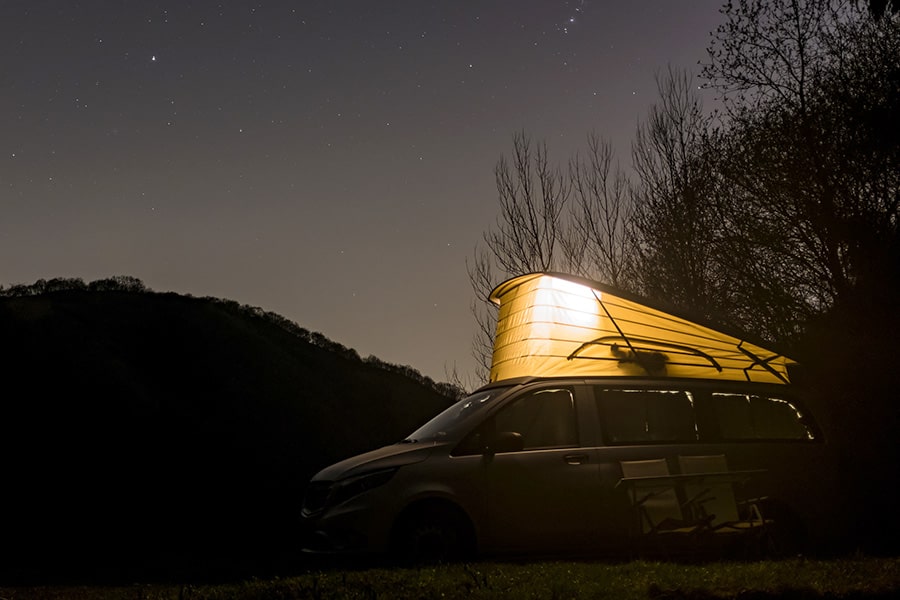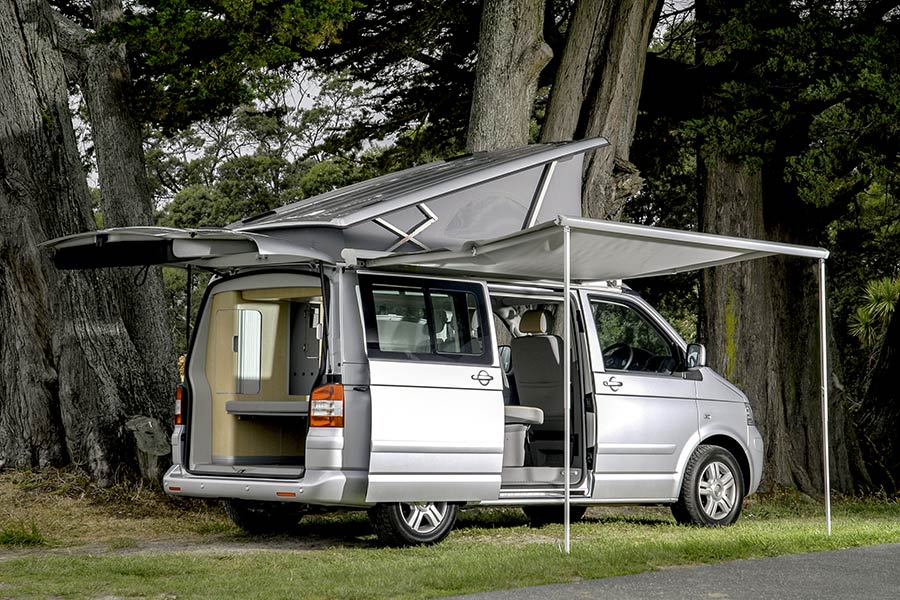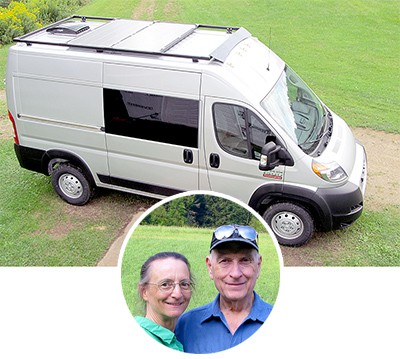
When you’re traveling in a van, it’s essential to stay hydrated and cooled off in the summer. Not only is it uncomfortable to sweat profusely in a vehicle, but it can also be very dangerous. Fortunately, it’s not as hard as it may sound to cool off.
If you want to know how to keep cool sleeping in a van, you need to focus on optimizing airflow. Built-in fans, cracked windows, and air conditioner units are a few great choices for everyone. That being said, there are all sorts of other options to go with.
Insulation is, without a doubt, the best barrier to reduce the temperature inside of your van. In addition to installing insulation in the ceiling and walls when converting your van, also make or purchase window covers to keep heat out. Use covers on the windshield and side windows to prevent the sun from shining into the van.
Insulating A Van To Keep The Heat Out
Insulation works great for maintaining the internal temperature of a vehicle, house, or any other structure. You can prevent heat from coming in or keep the cold air out with insulation. If you’re considering road trips or camping in a van, you should absolutely insulate it as soon as you can.
You need to start the insulation process before any other van construction. Installing insulation after shelves have been put in, beds have been built, or storage containers are placed inside can be a challenge.
If you regularly read our van camping blog, you know that we are big fans of sheep wool insulation. We used sheep wool in our first van, and we are in the process of converting a second van and guess what we are using for insulation? You guessed it, sheep wool.
Sheep Wool Insulation
Sheep wool is non-toxic, resists vermin and mold, and is naturally fire-resistant.
This amazing natural product is growing in popularity for van conversions due to its ability to help control moisture, lack of toxic chemicals, no off-gassing, ease of installation, soundproofing qualities, and many other benefits.
Also, sheep wool will help manage moisture, and this is critical when converting a van. Condensation will build up overnight just because you are breathing, and if you cook in your van, that is going to add additional moisture. Sheep wool helps combat this moisture.
While we are on the topic of condensation, you should consider installing a vent fan. It is a great way to help remove moisture that accumulates in your van. We will get into this in a little more depth in the next section.
Vapor barriers are not recommended when using this type of insulation on your DIY van project. It is okay to allow this product to breathe, for lack of a better term. Also, sheep wool absorbs harmful chemicals.
Sheep wool insulation comes in rolls or batts, and you can easily pull off pieces to fit into any awkward spaces and holes that your van has. You want to fill as many of the nooks and crannies that you can find.
You don’t have to wear a mask, long-sleeved shirt, and you won’t have any of those nasty fiberglass particles floating around in your van.
Insulating with sheep wool is not only beneficial for keeping the heat in during the colder times of the year, but keeping heat out in the hotter times of the year. You want to keep your van comfy all year round, and this product is an excellent choice to accomplish that.
One of the drawbacks to sheep wool insulation is that it is a little more pricey than the fiberglass insulations, but the benefits to your health far outweigh the cost factor.
Wool is excellent for insulation, and it slightly outperforms fiberglass. The R-value of sheep wool is approximately 3.5 to 3.8 per inch of thickness. And the loose-fill beats even that. Rolls or batts work the best for vans, and you will have to use string or wire to hold it in place.
We have a post “Is Sheep Wool Insulation Safe?” that will provide you with more information on this great insulating product.
Use Roof Vent Fans And Portable Fans
One of the foremost things you can do to stay cooled off in a van is to install a roof vent fan. They offer fantastic airflow, and you don’t need to be an electrician to install them. You can crank the top lid open an inch or all the way depending on how much airflow you’re looking to get. Some of them also have multiple speeds.
Most roof vent fans have connections that need to be hooked up to a deep cycle battery. You can’t hook it up to your car battery, which means you’ll have to get a separate battery for around $100. Charging the battery also requires a portable charger or solar power.
You can easily install solar power in your van without spending too much money. This installation will keep your deep cycle battery charged, instantly providing power to your roof vent fan, refrigerator, and more. Once you’ve hooked up the roof vent fan, you can start using it throughout the day.
This roof vent fan from Maxx Air is an excellent choice, it is 14 x 14 inches and has 10-speed intake and exhaust. The vent has twin arms and a 12-inch fan with 10 blades. Mounting screws and hardware are included; however, you must purchase roof sealant to complete the project.
If you decide to get a vent fan, there are a few issues that you need to consider first:
- You’ll have to cut a 14 x 14-inch square hole in the top of your van. This cutting process alone is enough to scare potential buyers away. With a jigsaw, it’s not too much of a challenge, as long as you’re good with power tools.
- There’s a screen on the top of the vent to keep out bugs, and you’ll need to clean it occasionally. Leaves, bugs, dirt, and other debris will build up over time and can clog the vent.
- When it’s raining, you won’t be able to use the vent fan too much. However, some of them have curved lids that allow you to crack it open about an inch or two without letting rain in.
Portable fans
Portable fans are another great solution to cool you off when you’re sleeping in a van. If you have solar power or other electrical connections, make sure that the wattage isn’t too high. Otherwise, you could try to use battery-powered fans.
Battery-powered fans don’t offer as much airflow, but every bit helps. You can purchase them for around $10, so why not grab a few of them and place them around the van? The only drawback to this is that you’ll need to have a few extra batteries ready to go whenever they run out.
Other Posts of Interest
- Why We Bought A Yeti Cooler
- Do Sleeping Pads Actually Keep You Warm?
- Van Camping vs. Truck Camping: What’s the Difference?
Airflow Is The Key Ingredient To Cooling Off
Anyone who’s traveled and slept in a van will tell you that airflow is the key component to staying cooled off throughout the day and night.
Not all vans have 5 windows spread around the interior, but even a single cracked window can make a huge difference. When you’re driving, try to keep the windows open at least an inch to lower the temperature for when you want to park and sleep.
The real secret with airflow is to combine it with some of the fans from the previous section. Crack the roof vent fan open, lower a window (preferably the one furthest from the vent), and watch the magic happen. The temperature inside will drop at least 5 to 10 degrees in only a few minutes.
You don’t need a roof vent fan to optimize airflow, though. Even the tiny portable fans that were mentioned will do just fine. Again, you should always open a window that’s the furthest from any fans that you use. The further, the better.
The reason that it’s so important to open windows far away from a fan is that it creates a small wind tunnel that pulls air right through from one side to the other. If you have a fan right next to a cracked window, the airflow area will be too small. With a big spread, you’ll be able to enjoy a lowered temperature from end to end.
Buy A Breathable Mattress
We’ve all had to sleep on a mattress that wasn’t breathable at all. Sweat builds up throughout the night hours, and it feels impossible to get some good sleep. If you plan on sleeping in your van, a breathable mattress is an absolute necessity.
Gel-infused memory foam is definitely a fantastic choice. You’ll receive the same cushioned comfort as memory foam without the excess heat that tends to happen. Memory foam by itself is much better than traditional mattresses, but getting a gel-infused mattress is even better.
The easiest way to see if your mattress is breathable is to push down on it. You should hear a ‘swoosh’ sound from the air coming out of it. The mattress should almost immediately return to its form (this step is more for comfort than breathability). That sound is a clear indicator that air can move in and out of it without heating up.
Finally, you need to make sure that the mattress is thick enough. If you buy a mattress that’s only 3 inches thick, it won’t have enough space to expand when you lay on it. Instead, try to find something between 4 to 8 inches.
Anything bigger would be okay; just try to avoid having the mattress too high (unless you’re in a high-top van). You don’t want to wake up in the morning and hit your head on the ceiling.
We have a post about how to choose a perfect mattress for van camping. It is a lot more detailed, so be sure to read it before making your selection.
Just as important as a mattress is a good set of sheets, blankets, and pillows cases. All of them need to be equally as breathable. Otherwise, the mattress won’t do any good at all.
Cotton offers a comfortable middle-ground that you can enjoy in hot or cold weather alike. Take it a step further by getting copper-infused cotton to keep you cooled off.
Change Your Parking Habits

Everyone loves to grab the spot right next to the water, on the edge of the mountain, or anywhere that they can get the best views.
Unfortunately, the best views don’t always grant the best environment when it’s hot outside.
You should change the way that you find your parking spots when you’re sleeping in a van. Always find the shadiest places since they’re going to make you feel the least hot at night. Shade during the day cools off the van for nighttime. It’s also great because it enhances the van’s insulation.
Those who park in the ‘best’ spots are left uncomfortably hot at night. Those who park near shade, underneath trees, and by the side of tall structures are much more likely to get a cooled down night’s sleep.
You can take this tip a step further by following the sun’s patterns. Find out where it’s going to rise in the morning and face you van sideways to it.
For example, if the sun is rising above a river, park your van horizontally. The sun should always hit the side of the van, not the front or back.
The reasoning behind this bit of advice is that windows are much more prone to letting heat in. You can have a frigid night and wake up to sweltering heat coming in through the windows. Parking your van sideways reduces the chance that you’ll wake up in a sweat.
The only time that you should change this rule is when it’s windy outside. Vans are kind of like wind sails when the weather turns bad. Facing your van towards the wind makes it much more aerodynamic, reducing the chance that it’ll rock around and keep you up all night. With proper parking next to trees and large structures, the wind will be cut down even more.
Van Camping Life Tip: When parking near trees, always be sure to look up to see if any dead limbs might fall and damage your van. The last thing you want is a great big dent or broken window in your van.
Consider Bringing An Umbrella Or A Tarp
Since we’re focused on shading your van throughout the day to benefit from it at night, tarps and umbrellas should be mentioned. Stretching a tarp over the top of your van is an excellent way to keep the sun from scorching you. Keeping it cooled down around the clock will let you stay relaxed when you sleep at night.
If you decide to use an umbrella, consider getting one that stands tall enough to shade your entire van. Better yet, try out a tent canopy and position it over the top of your van. You’ll have complete shade anywhere you park. The only downside is that your solar panels (if you have any) won’t absorb the sun at all.
You’ll also be able to use either the tarp or the umbrella as a wind-break. Many places that are warm during the day come with windy nights, like Florida and Georgia. Reducing wind while cutting down on heat is a win-win situation.
Tint Or Shade Your Windows
As mentioned earlier in the article, windows let in lots of heat if you don’t correctly tint or shade them. Before you sleep in the van, consider having a professional tint the windows. You’ll be able to cut down on the heat intake by up to 40% for lighter tint and up to 80% for darker window tinting.
Another reason that you might want to use window tinting is for privacy purposes. People can’t see inside of a van that has proper tinting on the windows. Less heat combined with complete privacy is a great deal for the low price of tint.
Even if you have tint on your windows, you should still put shades on them. The reduction of the sun’s penetration is a fantastic boost, but shades will almost cut it out completely. You can use Reflectix to cut out shapes that match your windows.
Making window shades with Reflectix
Here’s a quick 5-step guide to making the perfect window shades from Reflectix:
- Buy the proper amount of Reflectix. Measure the width x length of each window and add them up. Most van windows can be covered with a roll that’s 24 inches x 10 feet.
- Cut out the basic square size from the Reflectix after you measure each window. Make sure that you leave a little extra Reflectix on each side (it is easier to cut off than add on!) Place them up against the window, mark them with a Sharpie, and round off each corner to match perfectly.
- Get some thin fabric, preferably black or any other dark color, and cut it out to the size of your Reflectix window cut-outs. You can get a brighter color for the inside of the window, but the outside of it should be dark to tint the window even more.
- Fasten the fabric shapes to the Reflectix cut-outs and remove the excess fabric. You should now have a window-shaped cut-out covered on both sides with fabric for every window.
- Attach the Reflectix to the window. Use Velcro or command hooks to stick the cut-outs to each window. Voila, you now have window covers.
You’ll now be able to remove your new insulated shades from each window whenever you need to. If you’re parked in one place all day, place the shades up to prevent the heat from coming in. They’ll allow you to sleep throughout the night and even into the morning without waking up from the heat.
On a side note, you should never drive with window shades covering the windows in your van. Not only is it dangerous because they block your vision, but a complete tint is also illegal in most states in the USA and many other countries.
Having a quick removal system to make it easier every time you drive is a good idea. This is where using Velcro or command hooks to attach the Reflectix is useful; you can add or remove the shades depending on whether you’re driving or parked.
Using Curtains To Cool Down The Van
Curtains will be your best friend when you sleep in a van. Much like window coverings, they offer great privacy. However, they’re also useful because they can cool down your sleeping area super quickly.
Vans are relatively small compared to most other spaces that need to be cooled off, but they have their own set of issues. Portable fans and vent fans help quite a bit, especially if you use them with curtains. Use a set of curtains to section off the bed area of your van to limit the area that can have access to the cold air.
The best way to do this process is to blast the air conditioner with the curtains open. Follow this up by quickly turning off the a/c, shutting the curtains, and turning on the roof vent fan. Even a small portable fan is fine to use with this setup.
You’ll immediately notice that the cold air will continue to circulate in the back of the van. It’ll reduce the temperature of your mattress and everything that’s within the curtained portion. Just make sure that you don’t forget to close the windows to keep in the low temperature.
If you decide to use curtains, try to get a thick, dark set. Thick curtains work much better for keeping in and dividing temperatures. A thin, porous curtain won’t do a lot in your favor. The darkness of a curtain will also act as a privacy barrier of sorts.
Get A Portable Fridge/Freezer Combo
Mini fridges are great for keeping your food and drinks cold, but they can also help you out quite a bit as well. Freeze a few water bottles to use as ice packs on those extra-hot days in summer. You can drink the slushie of ice and water once it starts to melt, which will lower your internal body temperature.
You should never use frozen meat or vegetables to cool yourself down. People seem to do this frequently, but it can actually make you sick if you eat certain foods that have been frozen and thawed over and over again. Stick with water and ice, and you’ll never run into these issues down the road.
You can read “Are Camping Fridges Worth It? These Ones Are!” it will provide you with a lot more useful information about camping fridges and which ones you should consider.
Using the fridge and freezer for an air conditioner won’t work, but you’ll undoubtedly embrace the cold air when you open it up. Consuming cold food and drinks right before bed will let you stay cooled down throughout the night. Just make sure you don’t drink too much, or you’ll have to get up in the middle of the night to go to the bathroom.
Don’t Live In The Van, Live OUT Of It
When it’s hot outside, you should do your best to stay outside of the van during the day. Your body temperature and breath are both going to increase the temperature inside of the vehicle. You’ll also find yourself enjoying the day much more outdoors rather than being cooped up in a small van.
You should also avoid cooking inside at all costs. Some people who camp out of their van end up cooking indoors, claiming that the roof vent fan is enough to remove carbon monoxide and other toxins.
Not only is cooking inside of a van dangerous for health issues and fire hazards, but it’s also the #1 way to heat up your van in an instant. The smells of food will linger, and the heat will stick around throughout the day. Cooking outside of the van will let you relax at night when you’re sleeping in a space that’s cooled off, free of excess heat.
Follow The Weather
Better than any advice in this post (aside from insulation and window shades) would be to follow the weather patterns. If you know a place will be 100 degrees Fahrenheit, try to avoid it. Instead, camp at a place that’s between 60 to 75 degrees during the daytime.
You might not always be able to drive several hours away simply to find better weather, but you can always find better altitude, shade, and other desirable features.
Wrapping It Up
There are plenty of ways to keep your van cooled down, allowing you a good night of sleep. Insulation is critical, followed by proper parking habits and good bedding. Here’s a basic rundown of everything you’ve learned in this post:
- Insulate your van to keep heat out.
- Make cut-outs using Reflectix and fabric to keep sunlight and warmth out of your van.
- Proper parking will change your nights and mornings dramatically.
- Try out an umbrella, a canopy tent, or a tarp to shade the vehicle.
- Following the weather will always be one of the best ways to stay cool at night.






